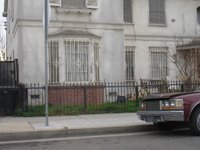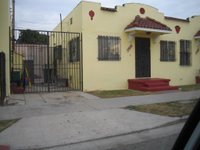Crime Part 2
Here's the thing I've learned: You can't convince someone, when convincing is necessary, that a neighborhood is safe. You can cite the crime statistics backward-and-forward, screen closed-circuit surveillance footage, wield signed testimony from the local SLO, it doesn't matter. People either feel comfortable or they don't, and the only thing that can change that is time.
Everyone has different visual triggers: loitering, the volume of parked cars, fences, the condition of painted surfaces, window bars.

Some cultures assume that window bars mark a place as unsafe. While other cultures embrace decorative metal security features as a home improvement item. Similarly, some cultures want to make all exterior space private, thereby making it more usable; whilst others condemn fencing, as isloating and symptomatic of social disjuncture.
Many older neighborhoods in Los Angeles have a large number of parked cars on the street because they haven't driveways, two-car garages, and easy off-street parking. Oftentimes the alley ways are decommissioned, the ipso facto exclusive domain of telephone technicians and kitty cats. This exacerbates street parking.

Metal security features are often pedaled door-to-door, and to older, more fearful residents, sometimes in the wake of a publicized event. Salespeople ask whether the resident feels safe, in a tone that evokes self doubt.
I drove through Larchmont Village recently and I noted plenty of bars, on sidelights in particular, and security doors. Does that make Larchmont Village unsafe? How dare I propose such a thing?!
I like my buyers to visit the site of a potential purchase both day and night, and on weekends. Typically, we walk around the block, and chat with a neighbor or two. Sometimes a real issue is identified, othertimes, an initial issue is ameliorated.
Safety is a serious issue in urban living, but you shouldn't judge a book only by the stain on its dust jacket.
Everyone has different visual triggers: loitering, the volume of parked cars, fences, the condition of painted surfaces, window bars.

Some cultures assume that window bars mark a place as unsafe. While other cultures embrace decorative metal security features as a home improvement item. Similarly, some cultures want to make all exterior space private, thereby making it more usable; whilst others condemn fencing, as isloating and symptomatic of social disjuncture.
Many older neighborhoods in Los Angeles have a large number of parked cars on the street because they haven't driveways, two-car garages, and easy off-street parking. Oftentimes the alley ways are decommissioned, the ipso facto exclusive domain of telephone technicians and kitty cats. This exacerbates street parking.

Metal security features are often pedaled door-to-door, and to older, more fearful residents, sometimes in the wake of a publicized event. Salespeople ask whether the resident feels safe, in a tone that evokes self doubt.
I drove through Larchmont Village recently and I noted plenty of bars, on sidelights in particular, and security doors. Does that make Larchmont Village unsafe? How dare I propose such a thing?!
I like my buyers to visit the site of a potential purchase both day and night, and on weekends. Typically, we walk around the block, and chat with a neighbor or two. Sometimes a real issue is identified, othertimes, an initial issue is ameliorated.
Safety is a serious issue in urban living, but you shouldn't judge a book only by the stain on its dust jacket.
Labels: Safety Dance

<< Home